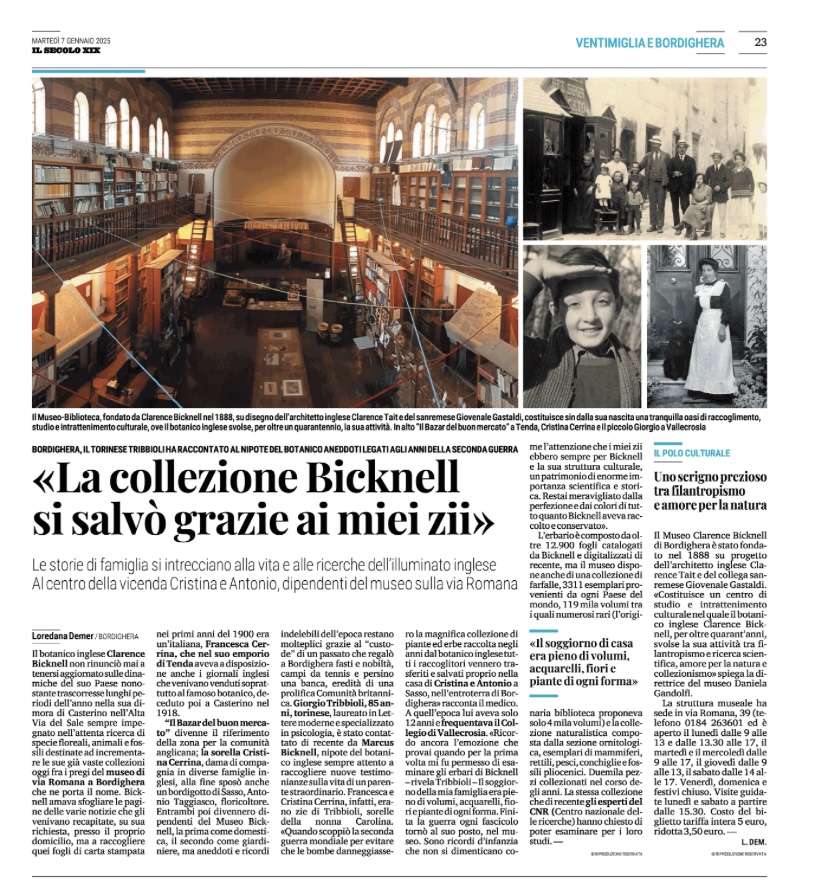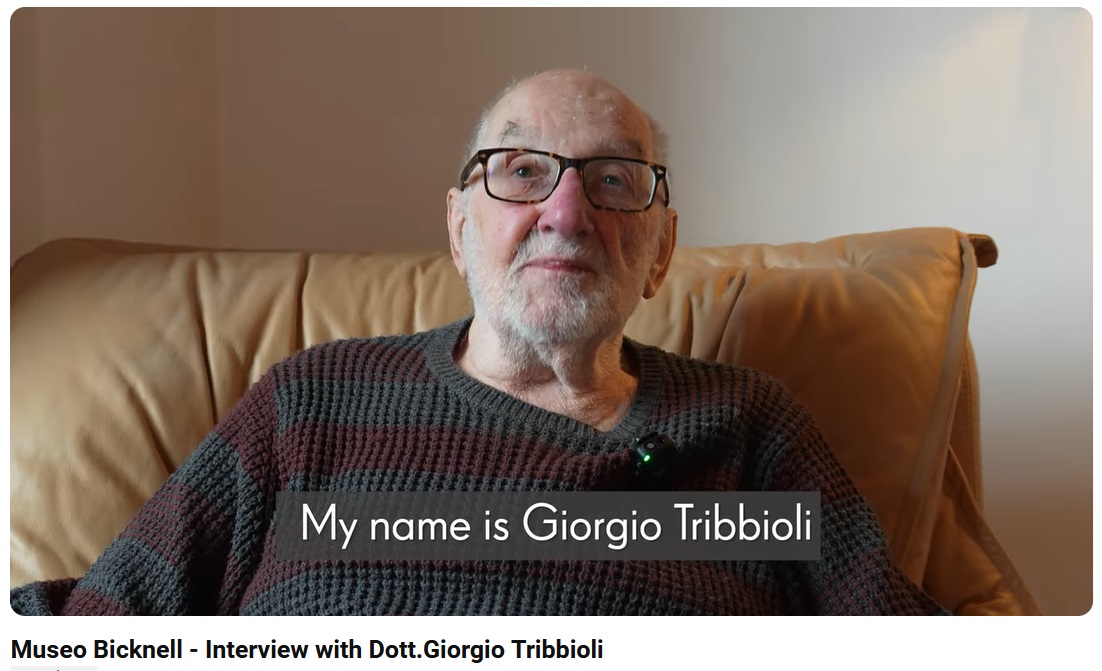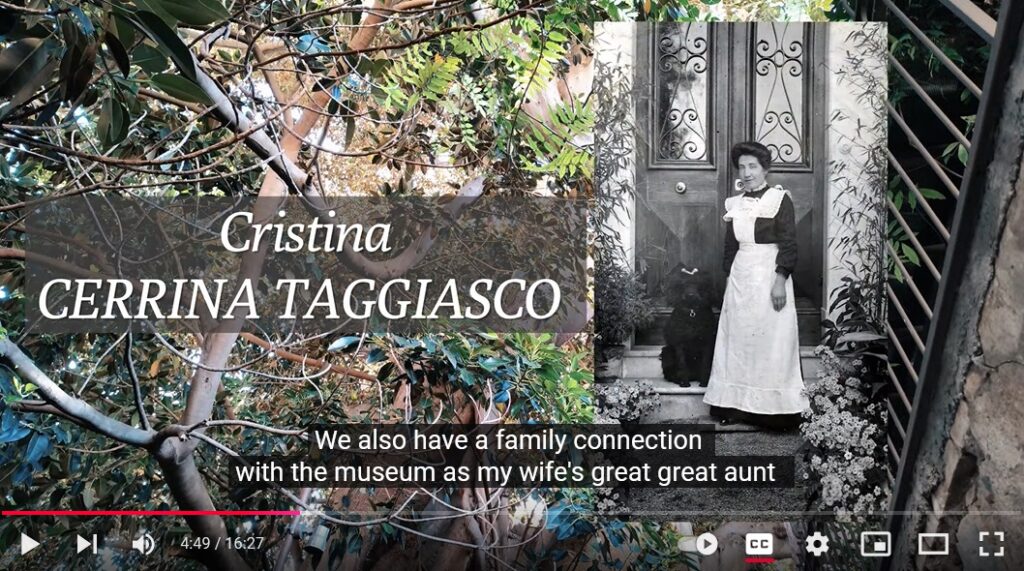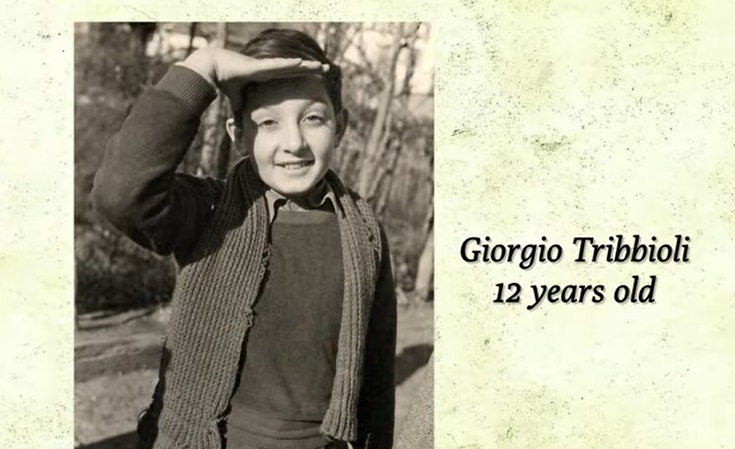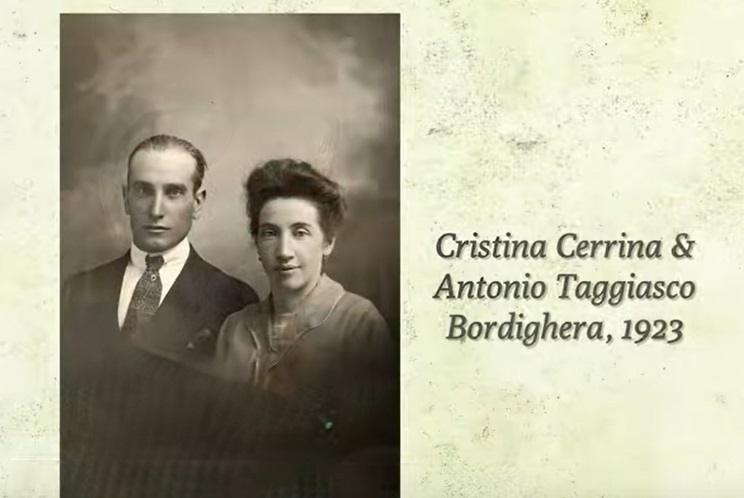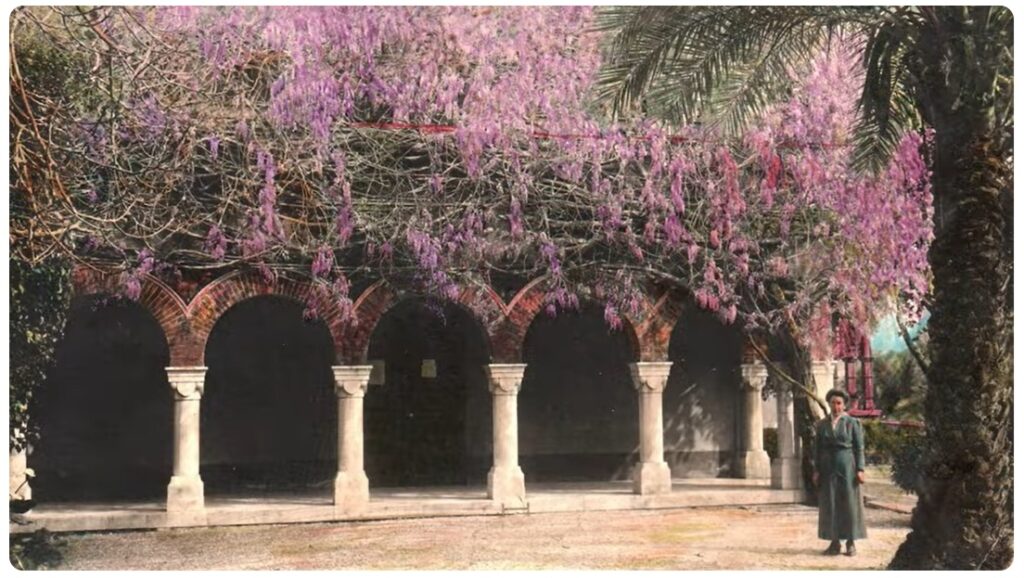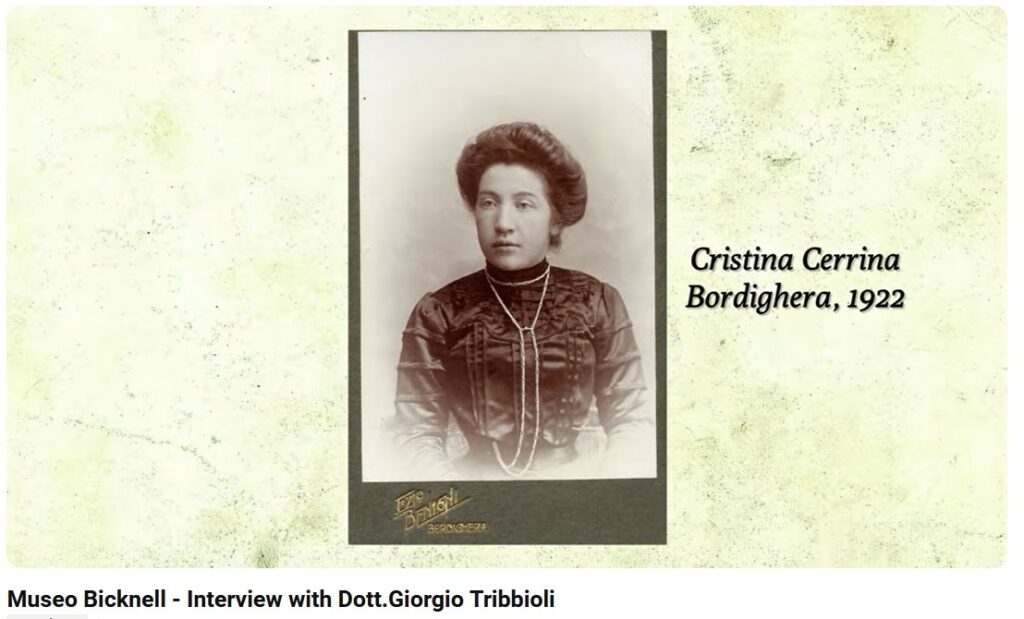On November 2024 we heard from Tim Leach about the family Tribbioli/Taggiasco and the Museo Bicknell. You can read the basic facts at https://clarencebicknell.com/tim-leach-the-family-tribbioli-taggiasco-and-the-museo-bicknell/. Tim was motivated by the interest to record a video interview with Giorgio Tribbioli whose great-grandmother Agnese used to sell newspapers to Clarence Bicknell in Tende and whose aunt Cristina was the curator of the Museo Bicknell in Bordighera. Cristina’s husband Antonio was the gardener there. We can feel blessed that when the Second World War broke out and there was a considerable risk of bombing, Cristina and Antonio moved hundreds of huge folders of plants and herbs from the museum to their home in order to distance the priceless collection from destruction.
The interview with Giorgio is both touching and informative. Even if you do not understand Italian please watch a few moments to soak in the depth of his feeling and the intrinsic value of his testimony. Click on this link to watch and listen
Tim, husband of Lorenza Tribbioli, Giorgio’s daughter, took the trouble not only to record the interview but also to transcribe Georgio’s words into Italian and thence into English. He has permitted me to reproduce them here …
In Italiano…
Mi chiamo Giorgio Tribbioli e pur essendo nato a Torino, la mia casa del cuore è a Tenda, perché mia mamma era di tenda e lavorava a servizio di tutta la famiglia, cioè tutti La chiamavano: si chiamava Agnese (come la bisnonna Agnese). “Vieni qua vieni là, fai questo fai quello…”, tutti la comandavano e quella che la comandava di più era la zia Cichina che era Francesca Cerrina, che aveva il negozio di giornali. Magnifico negozio di giornali.
Vedevo sempre dei giornali inglesi e mi chiedevo, “Ma perché avete dei giornali inglesi'”. Poi mi hanno detto che ricevevano parecchi giornali inglesi, e poi veniva un emissario di Bicknell da Casterino e gli dava i giornali inglesi che li portava a Casterino a Bicknell. Questa è una bella storia, una bella vicenda.
Quindi la mia bisnonna Agnese serviva Bicknell coi giornali. E la figlia Cristina? Cristina Cerrina in origine lavorava presso delle famiglie inglesi a Bordighera o in quei posti lì. Poi a un certo punto diventò, non so come, ma diventò custode del museo Bicknell che era stato appena aperto e quindi la zia Cristina, che si sposò con Antonio Taggiasco, diventò Cristina Taggiasco.
La zia Cristina nel museo era veramente una custode, mentre il marito Antonio Taggiasco divenne il giardiniere del museo Bickell. Quando purtroppo a un certo punto scoppiò la seconda guerra mondiale e c’era un rischio di di bombardamenti notevole, per proteggere la meravigliosa collezione di piante e di erbe del Bicknell che era una cosa enorme, grandiosa, dal museo trasferirono tutti questi enormi faldoni nella casa della zia Cristina e di zio Antonio e io che ero in collegio a Vallecrosia, dove ho fatto le scuole medie, andavo sovente a trovare la zia Cristina al Sasso.
E lì mi ricordo che nel suo salone/soggiorno non c’era quasi più spazio per mangiare, per i tavoli, ma c’erano tutti questi enormi e numerosissimi faldoni di Bicknell. Io ero un ragazzo curioso e la zia Cristina mi permetteva di sfogliarli per cui io mi ricordo ancora, malgrado gli anni che sono passati, di quando sfogliavo questi enormi faldoni dove c’erano tutte le piante e i fiori raccolti da Bicknell. Questa è una delle memorie più belle che io ricordi. Poi, finita la guerra, a un certo punto ovviamente il museo è andato al Sasso di Bordigera e ha portato via tutti questi faldoni che adesso sono nel museo come è giusto che sia.
Però io ho il ricordo bellissimo di averli sfogliati e di averli apprezzati veramente moltissimo. Ricordi d’infanzia.
In English…
My name is Giorgio Tribbioli, and although I was born in Turin, in my heart I am from Tenda because my mother was from Tenda. She worked for the whole family. Everyone used to call her. Her name was Agnese like my great-grandmother. “Agnese, come here, go there, do this, do that.” Everyone ordered her around, and the one who ordered her around the most was Aunt Cichina, who was Francesca Cerrina, who had the newspaper shop, a wonderful newspaper shop.
I always saw English newspapers and I used to ask myself “Why do you have English newspapers?” Then they told me they used to get a lot of English newspapers and then someone from Bicknell’s house would come from Casterino to collect the English newspapers for Clarence Bicknell [at the mountain house – Casa Fontanalba – he built in 1906] in Casterino. This is a beautiful story.
So my great-grandmother Agnese used to sell newspapers to Bicknell. And her daughter? Cristina? Cristina Cerrina originally worked for English families in Bordighera, or in those places there. Then at some point she became – I don’t know how – she became the custodian of the Museo Bicknell that had just been opened. And then Aunt Cristina, who married Antonio Taggiasco became Cristina Taggiasco.
Aunt Cristina was the museum custodian, while her husband Antonio Taggiasco became the gardener of the Museo Bicknell. When, unfortunately, the Second World War broke out, and there was a considerable risk of bombing, in order to protect the wonderful collection of plants and herbs from the Bicknell museum – which was an enormous, grandiose thing – from the museum they moved all these huge folders to Aunt Cristina and Uncle Antonio’s house. I was at boarding school in Vallecrosia where I went to secondary school and I often went to visit Aunt Cristina in Sasso.
And there I remember that in her sitting room there was hardly any room for eating, for tables, because there were all these huge folders from the Museo Bicknell. I was a curious boy and Aunt Cristina let me leaf through them, so I still remember, despite the years that have passed, leafing through these huge folders where there were all the plants and flowers collected by Bicknell. This is one of the most beautiful memories I have. Then, when the war ended, at some point of course, the museum people came to Sasso di Bordigera and took away all these folders, which are now in the museum, as they should be.
But I have a wonderful memory of leafing through them and really enjoying them. Childhood memories!
Tim writes “I’ve never really filmed an interview before, or made a multi-camera video, so this was a bit of a learning experience, but I’m quite pleased with the results. I hope you like it!” I certainly like it, both Giorgio’s fluent performance and Tim’s visual and technical skills. I applaud their efforts and their willingness to share it with the Clarence Bicknell web site and social media because this fascinating story is now in the public record. The most valuable permanent assets of man are tangible remains (like great buildings and art) and intangible cultural heritage … the memories, the books, the record of what individuals did to contribute to our culture. This small story is just one of those but, as of now, there is a permanent record, publicly-accessible on the internet, of the museum custodian and husband gardener who saved the collection from possible destruction. We know that Clarence took newspapers from Tende up the Casa Fontanalba in Casterino. We thank Tim, Georgio and the family for establishing this fascinating record.
Not only the Clarence Bicknell Association but also the national press has covered this story. Lorenza contacted the newspaper Il Secolo XIX via my friend Loredana Demer who knows all about Clarence. The journalist spoke with Giorgio and published an excellent story on 7th January 2025 of which we show below an image for you to read. Loredana not only writes a great account of the Tribbioli story but also add details of the Museo Bicknell and it opening times. Go for a visit and see what it was that Aunt Cristina and Uncle Antonio saved for posterity.
- See the initial story about saving the contents of the Museo Bicknell in WWII at https://clarencebicknell.com/tim-leach-the-family-tribbioli-taggiasco-and-the-museo-bicknell/
- Download and read the article in Il Secolo XIX here…
